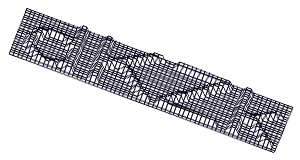|
|

CAPTCHA - Completely Automated Public Turing test to tell
Computers and Humans Apart
Overview
Captchas are a visual challenge/response mechanism often used to deter automated (non-human)
attempts to access online services.
The art of developing visual Captchas rests in the balance of a) detering computer recognition of an
image, b) while retaining the ability of humans to recognize the image, and c) minimizing
the the cost/time required to generate the Captcha image.

2D Captchas
Most Captchas rely on 2D warping of text, overlayed with visual noise
to confound automated image recognition.
Unfortunately, this often makes the Captcha image too difficult for humans to recognize, while
providing
limited impedement
to automated recognition systems.
Many Captchas use color to further obfuscate the image - however, the first thing most
image recognition systems do is remove/ignore the color, and simply look for visual edges in the image.
In other words, color can provide an aesthetic value, but it provides little useful deterent
for automated recognition, and may reduce readibility for color-blind users.

3D and Isometric Captchas
Humans are currently much better at recognizing objects and shapes in 3D, than are computer
vision systems.
As a result, warping and noise become less necessary as a deterent, improving human
readibility of Captcha images.
3D Pitfalls
The image on the above right is an example of a 3D Captcha - however, it provides several
hints to computer vision systems that make it make it relatively easy to defeat:
The grid provides a bounding box, which reduces the area that needs to be scanned.
The grid provides the orientation of the text, making it trivial to normalize.
The grid is relatively noiseless (few bumps), making it easy to mask out.
What remains can be identified via a standard Optical Character Recognition (OCR) system.
3D / Isometric Examples

Isometric
|

3D Slices
|
The above examples attempt to obfuscate the text bounding box and orientation
through introduced noise, while highlight/shadows deter conventional OCR systems.
An automated vision system could eliminate the noise through a low-pass filter,
but this would further degrade the text, providing less accurate recognition.
Overall, these examples provide a reasonable balance between a) human recognition and
b) automated deterence, while providing c) speed and a low cost solution.
The registration page on this LAMP-based site uses the
above approaches, adding random fonts and 3D transforms.
For more information on 3D Captcha,
contact this site's sponsor.
|
|
|
